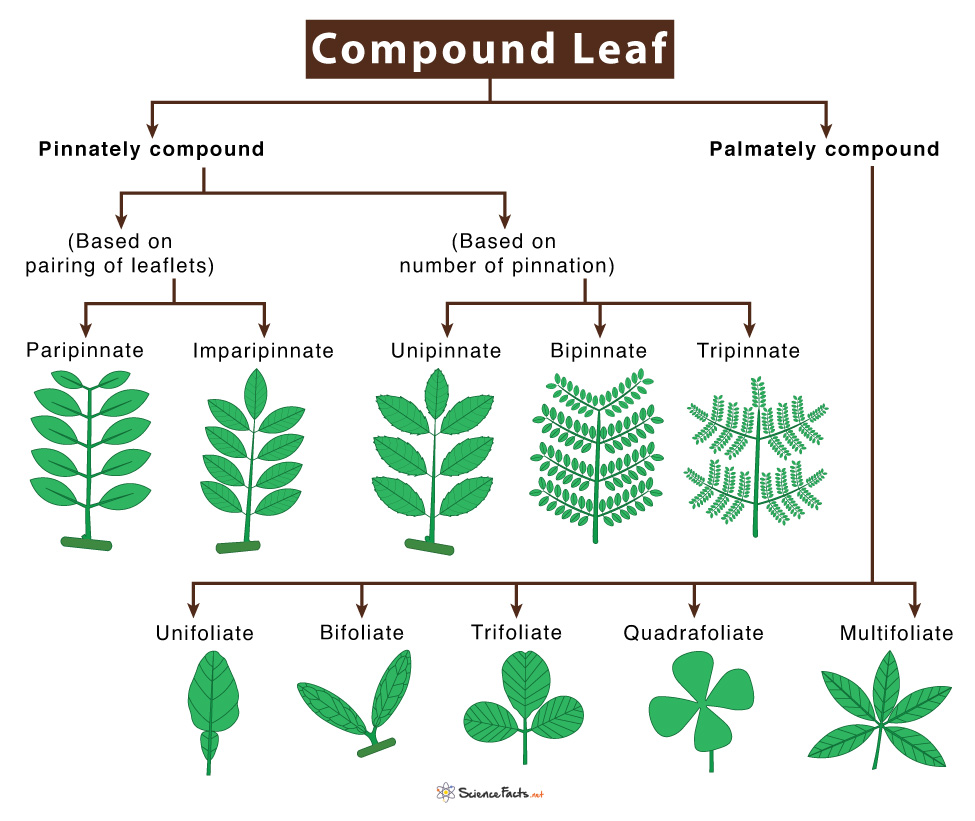Compound Leaf
Based on the arrangement of the lamina, the broad, thin, flattened surface of the leaf, leaves are broadly of two types: simple and compound.
What is a Compound Leaf
A compound leaf is composed of multiple leaflets attached to the midvein, having their own stalks. Each leaflet of a compound leaf remains attached to the main stem by a short stem-like structure called the rachis.
Examples: Neem, clover, rose, hickory, walnut, pecan, ash.
Types of Compound Leaves
Based on the arrangement of leaflets, compound leaves are classified into two types, which are again divided into many more types.
Pinnately Compound
In this type of compound leaves, the leaflets arise symmetrically from either side of the central leaf stalk. These leaves get their name from the Latin word ‘pinna’ meaning ‘feather’, or ‘wing’, as here the leaflets look like they are pinned to the midrib of the leaf, resembling a feather.
Example: Hickory, ash, walnut, pecan, black locust.
Types
1. Based on pairing of leaflets
The leaflets of these leaves may be paired evenly or oddly. Depending on that, pinnately compound leaves are of two types:
- Paripinnate or even-pinnate: Leaflets are borne in pairs along the rachis, ending with a pair of leaflets on either side.
- Imparipinnate or odd-pinnate: Unlike paripinnate, here, a single leaflet is present at the anterior terminal end of the rachis.
2. Based on number of pinnation
Depending on how many times the leaflets are getting attached or pinned to the midrib; pinnately compound leaves are classified into the following types:
- Unipinnate: Single compound leaf with a row of leaflets arranged or pinned along each side of the midrib oppositely. Example – Neem.
- Bipinnate: Here, single leaflets of the unipinnate leaf get replaced with unipinnate leaves. In this case, leaflets are arranged on secondary stems, which grow off the main stem, or rachis. Thus, the pinnation occurs twice, once between the leaflets and the secondary stem and the other between the secondary and main stem. This arrangement is also known as double pinnate or double compound leaf. Example – touch-me-not.
- Tripinnate: Similar to the previous type, the single leaflets of the unipinnate leaf get replaced with bipinnate leaves. So, the pinnation occurs thrice, thus giving the name. Example – drumstick tree.
Palmately Compound
Palmately compound, as the name says, these leaves look like the palm of our hands. Here the leaflets radiate outwards from the petiole, resembling the fingers of the palm. The petiole or leaf stem, in turn, gets attached to the twig.
Example: Buckeye, horse chestnut, poison ivy, umbrella plant.
Types
Based on the number of leaflets, the palmately compound leaves are of the following types:
- Unifoliate: One leaflet, e.g., lemon.
- Bifoliate: Two leaflets, e.g., Chinese orchid tree.
- Trifoliate: Three leaflets, e.g., ivy-leaved maple.
- Quadrifoliate: Four leaflets, e.g., Oxalis.
- Multifoliate: Five or more leaflets, e.g., umbrella plant.
Compound Leaf Identification
An easy way to identify compound leaves is to look for the lateral buds. Every leaf has a lateral bud at its base. However, in the case of a compound leaf, the lamina gets divided into leaflets. Hence, no buds are present at the base of each leaflet.
FAQs
A: Papaya leaf is a palmately compound leaf.
A: Ginkgo leaf is a simple leaf.
A: Tamarinf leaf is a pinnately compound leaf.
A: Maple leaf is a simple leaf.
-
References
Article was last reviewed on Thursday, February 2, 2023




